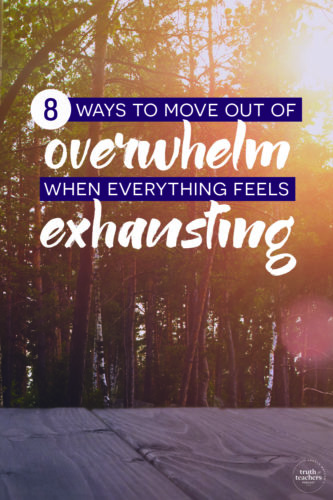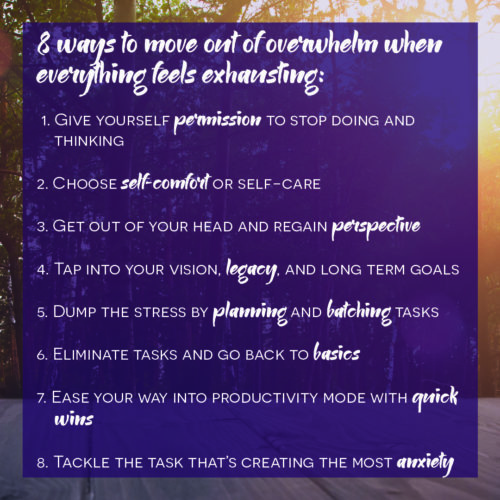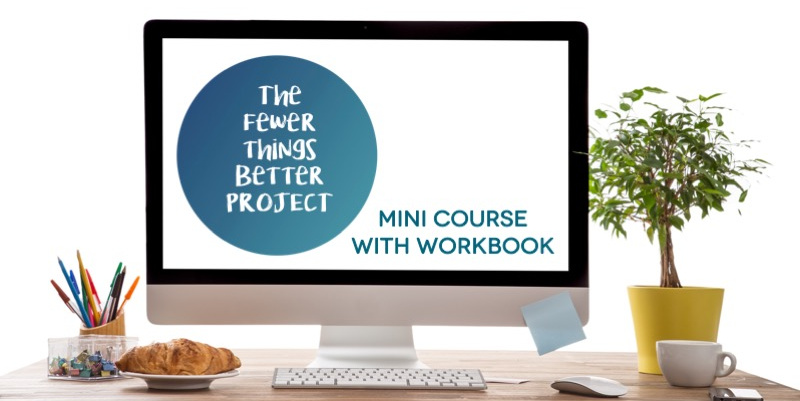You know those moments when you look at your to-do list, and feel like you can’t do anything on there because you’re so exhausted?
When just basic adulting feels like too much?
When you can’t get motivated because everything feels hard and there are so many things that need to happen you wouldn’t know where to begin even if you had the energy to try?
I’ve found it empowering to have a menu of choices or a toolbox I can go to when I experience those feelings. It’s a collection of strategies I can pick from which have worked in the past, so I can choose whichever one feels easiest to me at the time.
I’m going to share those eight approaches here, starting with those that require the least effort and willpower and working up to those that require the most.

Want to listen instead of read?
Download the audio, and listen on the go!
1) Give yourself permission to stop doing and thinking
If you have no clarity and zero energy to get things done, it likely means you need to release yourself from the pressure to be productive. You might need a break from the task you’re trying to convince yourself to tackle, but you might also need a break from life.
Granting yourself permission to put the to-do list away is sometimes the most powerful strategy in the overwhelm toolbox. I often find that when I allow myself to take a break with no guilt, I get motivated to jump back in the game far more quickly afterward.
It’s not a cop-out to decide you’re done for the day at 4:00 pm, and do as little as possible for the rest of the evening. Rest is the catalyst for productivity, so you’re far more likely to wake up feeling energized and clear-headed than if you force yourself to press on with tasks that you’re just not that into.
If taking the evening off isn’t an option, try giving yourself an hour in which you can do whatever you feel like, guilt-free, instead of getting things done. Don’t ignore your body’s signals. Ask yourself, Will I do a better job at these things I need to get done if I rest and recover first?
If the answer is yes, flow with your natural energy patterns. Take a true break, not only from working but from thinking about work. Release yourself from the guilt of “not doing anything” and trust that you will have more focus afterward.
The more you practice “permission to stop,” the easier it becomes to trust yourself not to fall into a lazy spiral where the less you do, the less you want to do. You’ll get back into the groove later IF you give yourself a true break and don’t feel bad about it.
2) Choose self-comfort or self-care
If you’re so physically exhausted and emotionally spent that trying to decide what to have for dinner feels overwhelming, you’ve probably gone too long without basic self-care practices that help you stay balanced.
See if you can identify the area of self-care you’ve been neglecting, and take one simple step to restore yourself:
- Has it been too long since you’ve gotten any fresh air? Take a 15-minute walk as soon as you can. No phone, no music. Just nature.
- Has your bedtime started creeping back later and later? Hit the bed early tonight, or take a quick nap instead of doing laundry.
- Have you spent more time scrolling mindlessly through social media than you meant to? Turn off the phone for the next couple of hours and be present with friends or family.
- Have you worked late every night instead of sticking to your self-imposed curfew? Set a timer this evening and cut yourself off from work so you can relax at home.
There will be times when you’ve let things deteriorate too far, and the idea of putting forth energy to care for yourself feels overwhelming. Sometimes self-care in the form of exercise and eating healthy is too much, and all you can manage is Netflix and cookie dough.
That’s where self-comfort comes in.
It’s okay to do something that feels like a treat and indulge your senses FIRST, then go back to your self-care habits. Just don’t allow yourself to settle for self-comfort in the long term.
3) Get out of your head and regain perspective
When the hassles of life are looming over you in an impossibly large pile, sometimes what you need is to take a step back. It’s time to find the big picture again, so that nasty email from a parent or uncertainty about which grade you’re teaching next year no longer feels like the end of the world.
Start by taking some deep breaths. This isn’t cliched advice — it brings more oxygen to your brain to help you think clearly and slows down your heart rate so you’re calmer.
Try breathing in for a count of 4, holding the breath for 2, breathing out for a count of 4, and holding the breath for 2. Repeating that process for just one minute can change your emotional state dramatically.
Ask yourself at that point, Will any of this matter 10 years from now? 5 years from now? Even just a year from now?
Getting around other people can help you regain perspective, too. I’m an introvert, so this isn’t always my instinct and takes some willpower to orchestrate, but it’s extremely effective.
Being around other people when I’ve been lost in my own head and overly focused on my own responsibilities is sometimes a light-hearted experience. It reminds me that there’s more to life than just the things I’m stressing about, and enjoying time with people I like rejuvenates me and brings a new outlook on my problems.
Being around others is often a reminder that whatever I’m facing feels super important because it’s my problem, but everyone else’s problems feel equally important to them. As Regina Brett once said, “If we all threw our problems in a pile and saw everyone else’s, we’d grab ours back.”
4) Tap into your vision, legacy, and long-term goals
This is a useful approach for major projects and creative tasks where it’s easy to lose steam halfway through. That happens to me a lot: when all the easiest and fun parts are done, I hit a part of the process that was unpleasant, mentally taxing, and a lot of hard work, and it’s really hard to get motivated.
Tapping into my long-term goals helps a lot. I am passionate about the work I’m doing and believe it’s making a difference. The stuff that gets hard at times — like finishing a book, or even finishing a podcast episode — well, the final product is going to be part of my legacy. I truly want to prioritize my work
And, I remind myself that the current project is only one of the things I want to do this year. I have other ideas which sound super fun or important right now, and I know I won’t have time to tackle them until I get the current project done.
So, my motivation to get it finished and move on to the next goal is also motivating: I’m looking forward to a time soon when the current task is in the rearview mirror, and I have more time to focus on other things that matter to me.
Think about your own goals, priorities, and legacy. Think about how you want to be spending your time a few months or years from now, and how the tasks you’re struggling to push through now are moving you forward. Envision how good it will feel when you’re done, and use those positive feelings to motivate you to get working.

5) Dump the stress by planning and batching tasks
I like this strategy for when I feel like I have an endless, disjointed list of things to do and many of them I don’t really care about. It’s the opposite problem of what I just described, when the work is important and meaningful and that’s what makes it overwhelming — the stakes are high.
But not everything on our to-do list is like that. Sometimes the stuff that’s draining our energy and motivation ISN’T moving our lives toward what we want, and none of the tasks feel important. How can you motivate yourself when there isn’t anything on the list you really want to do?
In those situations, try dumping all of the stress somewhere. It doesn’t have to be an organized list at first, but get everything out of your head and onto a piece of paper or digital note. That will keep you from trying to hold all your responsibilities in your mind.
Remember that many of life’s little annoyances can be batched and completed on one or two set days each week, on a buffer day. If your to-do list is cluttered with tasks like “make vet appointment for the dog” and “clean out hall closet” and “file paperwork” and that’s overwhelming you, shift all those things over to one day where you don’t do any big project or deep work, and handle the little stuff in life that piles upon you.
Then, try to batch the remaining tasks together so they feel more meaningful. If you have a bunch of phone calls to make, give yourself a half-hour one day this week for making them all at once, and then you don’t have to think about phone calls again for awhile. If there’s a handful of minor household repairs that you’ve left undone, write them on your to-do list for Saturday morning, so when you’re done, you feel the satisfaction of having everything taken care of.
Batching is a much more satisfying (not to mention efficient) way to work because you’re getting all of the emails finished or handling everything related to organization, rather ending your day feeling like you did a hundred things but have no memory of what any of them were because they were so trivial.
6) Eliminate tasks and go back to basics
This is my go-to strategy when I know I’ve overcommitted myself and I’ll never be able to get everything done that I had hoped. I usually resort to this strategy when I find myself pushing the same tasks back over and over. You know how it goes:
Wake up on Monday: Nope, don’t want to do that.
Wake up on Tuesday: Nope, still don’t want to get this done.
After a few days of that, I get fed up, and start eliminating:
Okay, let’s get real. This is just not happening. Does it really have to be done? Does it have to be done by me? Does it have to be done by me right now? Does it have to be done by me right now to the fullest extent I’d planned?
Part of the success of this strategy involves giving yourself permission to stop trying to do so much right now. It’s showing yourself grace, and treating yourself with compassion.
If a friend was super overwhelmed, you’d never tell him or her, “Suck it up, buttercup. You gotta do it all now.” You’d help your friend let go of some things she’s putting extra pressure on herself to do right now, and encourage her to delay or delegate them. Treat yourself with this same kindness.
Try stripping away everything that you thought you “had” to get done today. Look at the first task. What would happen if an emergency cropped up and you absolutely could not do it? If you could get away with not doing it in emergency, what’s to stop you from getting away with not doing it now? Do you have to add it to your to-do list for the day?
Keep going through the tasks in this manner, and only writing down tasks that absolutely have to be done by you right now. By focusing on what’s really essential, it’s easier to move back into productivity mode and get some forward momentum.
7) Ease your way into productivity mode with quick wins
Even after you’ve gotten some rest, done some self-care, and eliminated all the tasks but your real priorities, you may still need to force yourself to get back in the productivity game.
I often start with things I can get done quickly. If I can knock a few things off the list in thirty minutes, then I feel like I’ve been more productive rather if I use those thirty minutes to start a two-hour project.
One teacher I know uses this approach when she’s feeling overwhelmed with the state of her classroom. She looks around the room after school and find things she can fix in 20-30 minutes. Once shes sees that progress, she makes a list of everything that she needs to do immediately and then a list of things she would like to do. She organizing the tasks by priority and chips away little by little over the next few weeks, re-evaluating as new and more important things come up.
The timer is a great tool: I promise myself I only have to work for 15 minutes, and then I can stop. When the timer is up, I’ve either gotten 15 minutes worth of stuff done (which feels infinitely better than zero minutes worth of stuff), or I’ve found myself in a flow and wanting to continue a bit more.
8) Tackle the task that’s creating the most anxiety
Though doing the easiest thing first and getting quick wins can help you ease back into productivity, it’s not always the right path if there’s something bigger that’s hanging over your head. Author Brian Tracy has a book called Eat That Frog, the title of which alludes to doing the least attractive task first. Sometimes, you’re just not going to get any relief from your anxiety until you do the thing that you’re most worried about.
Try breaking down the dreaded task (which is likely a big project) into easier, smaller steps. So if report cards are due, the steps you might write down are: finish grading papers; add all grades to gradebook; calculate grades; add grades to report cards; compose comments; send to principal.
Once you can see the steps in front of you, the task feels less overwhelming. You get the satisfaction of crossing off each step as you complete it and can see how each task you do is moving you toward your end goal.
And if it’s too much to do in a single day, you can feel good about having completed a couple of steps instead of feeling like all you did was start something and didn’t finish it. You’ll know exactly where to begin tomorrow — with the next step — instead of feeling you’re just wrapping up loose ends from the day before.
Just observe what works and when, and keep experimenting. Over time, you’ll develop your own toolbox of strategies to help you get unstuck when you’re trapped in overwhelm.
Your takeaway truth for the week ahead is a quote from my book. It says: “The solution to overwhelm is NOT to manage your time better or work more efficiently. Or at least — that’s not the place to start. The most important step is getting clarity: figuring out what matters most, so you can do fewer things better.”
When overwhelm and exhaustion become your primary state of being, I encourage you to take that step back to get clarity and focus. Often there are simple changes to our workload and routines we can make that will make a HUGE difference in our energy levels and feelings of satisfaction if we can just step out of auto-pilot for a moment and approach life with consciousness and intentionality.
The “Fewer Things, Better” mini-coure will help you ask yourself the right questions, and help you think through the answers to choose an approach that’s right for YOU.

Get the FREE mini course and downloadable workbook!
The Truth for Teachers Podcast
Our weekly audio podcast is one of the top K-12 broadcasts in the world, featuring our writers collective and tons of practical, energizing ideas. Support our work by subscribing in your favorite podcast app–everything is free!
Explore all podcast episodes
Angela Watson
Founder and Writer
Discussion
Leave a Reply
OR

Join our
community
of educators
If you are a teacher who is interested in contributing to the Truth for Teachers website, please click here for more information.



















Great ideas but may be tough to implement on a regular basis
This, is short sited. Life is complex because of other people, organizations, and governments. You are asking people to treat symptoms vs tackling the root causes. Its like treating pain, but the patient has cancer. Basically you said suck it up, in alot of words.
I think there is a difference between blaming someone for their overwhelm, and giving them tools they can use to help cope with the overwhelm. I hope this article falls in the latter category! I’ve written a book on this subject (linked in the post) which includes a more comprehensive look at the systemic factors that create burnout, and there are a number of articles and podcast eps here that cover that as well. Hope you find something else here that is useful.